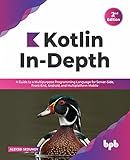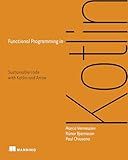Best Kotlin Programming Books to Buy in December 2025

Kotlin in Action, Second Edition



How to Build Android Applications with Kotlin: A hands-on guide to developing, testing, and publishing production-grade Android 16 apps



Kotlin In-Depth: A Guide to a Multipurpose Programming Language for Server-Side, Front-End, Android, and Multiplatform Mobile (English Edition)



Head First Android Development: A Learner's Guide to Building Android Apps with Kotlin



Kotlin from Scratch: A Project-Based Introduction for the Intrepid Programmer



Head First Kotlin: A Brain-Friendly Guide



Functional Programming in Kotlin


To loop over two ArrayLists of different sizes in Kotlin, you can use a loop with an index variable that iterates over the smaller size of the two ArrayLists. Within the loop, you can access elements from both ArrayLists using the index variable. You can also check if you have reached the end of either ArrayList before accessing its element to avoid ArrayIndexOutOfBoundsException. Alternatively, you can use the zip function to combine the two ArrayLists into pairs and then iterate over these pairs using a loop or forEach function.
How to check the size of each ArrayList before looping over them in Kotlin?
You can use the size property of an ArrayList to check its size before looping over it in Kotlin. Here's an example:
val list1 = arrayListOf(1, 2, 3) val list2 = arrayListOf("a", "b", "c")
if (list1.size > 0) { for (item in list1) { println(item) } }
if (list2.size > 0) { for (item in list2) { println(item) } }
In this example, we first check if list1.size > 0 before looping over list1, and then check if list2.size > 0 before looping over list2. This approach ensures that you only loop over the ArrayList if it contains elements.
How to benchmark the performance of different looping strategies for iterating over two ArrayLists in Kotlin?
One way to benchmark the performance of different looping strategies for iterating over two ArrayLists in Kotlin is to use the measureTimeMillis function from the Kotlin standard library. This function measures the time taken to execute a block of code and returns the result in milliseconds.
Here is an example of how you can use measureTimeMillis to benchmark the performance of two different looping strategies for iterating over two ArrayLists:
import kotlin.system.measureTimeMillis
fun main() { val list1 = arrayListOf(1, 2, 3, 4, 5) val list2 = arrayListOf(6, 7, 8, 9, 10)
// Looping strategy 1: Using two separate loops
val time1 = measureTimeMillis {
for (i in list1) {
for (j in list2) {
// Do something with i and j
}
}
}
println("Time taken for looping strategy 1: $time1 ms")
// Looping strategy 2: Using one loop with nested indices
val time2 = measureTimeMillis {
for (i in list1.indices) {
for (j in list2.indices) {
// Do something with list1\[i\] and list2\[j\]
}
}
}
println("Time taken for looping strategy 2: $time2 ms")
}
By comparing the time taken for each looping strategy, you can determine which one performs better for iterating over the two ArrayLists. Keep in mind that the actual time measurements may vary depending on the size of the ArrayLists and the complexity of the operations performed within the loops.
How to break out of a loop when looping over two ArrayLists in Kotlin?
One way to break out of a loop when looping over two ArrayLists in Kotlin is to use a combination of forEach and return@forEach statement to exit the loop. Here is an example code snippet demonstrating this technique:
fun main() { val list1 = arrayListOf(1, 2, 3, 4, 5) val list2 = arrayListOf(6, 7, 8, 9, 10)
list1.forEach { item1 ->
list2.forEach { item2 ->
println("Item from list1: $item1, Item from list2: $item2")
// Check for a condition to break out of the loop
if (item1 + item2 == 10) {
return@forEach // Break out of the inner loop
}
}
}
}
In this example, we are looping over the elements of list1 and list2 using nested forEach loops. When a condition is met (in this case, the sum of two elements from the lists equal to 10), the return@forEach statement is used to break out of the inner loop and resume execution of the outer loop.
This technique allows you to break out of the loop at a specific condition without using break or continue statements, which are not directly supported in forEach loops in Kotlin.
How do I optimize the looping logic for better memory utilization while iterating over two ArrayLists in Kotlin?
To optimize the looping logic for better memory utilization while iterating over two ArrayLists in Kotlin, you can consider the following suggestions:
- Use Iterators: Instead of using indexed for loops, use iterators to iterate over the ArrayLists. Iterators are more memory-efficient as they do not store the entire list in memory.
- Use Kotlin Sequences: Kotlin Sequences are similar to iterators and provide a more memory-efficient way to process large collections. You can use the asSequence() function to convert the ArrayLists to sequences before iterating over them.
- Use zip function: The zip function in Kotlin allows you to iterate over two lists simultaneously. This can help reduce memory usage as it does not require creating a separate iterator for each list.
- Avoid creating unnecessary objects: Try to minimize the creation of unnecessary objects within the loop. For example, avoid creating new objects on each iteration if they can be reused.
- Use filter and map functions: Instead of iterating over the entire list, consider using the filter and map functions to process only the elements that meet certain criteria. This can help reduce memory usage by avoiding unnecessary iterations.
By implementing these strategies, you can optimize the looping logic for better memory utilization while iterating over two ArrayLists in Kotlin.
